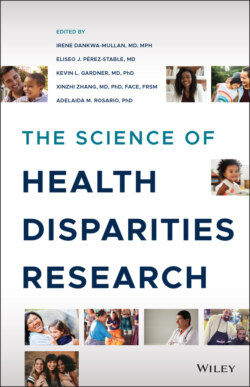Читать книгу The Science of Health Disparities Research - Группа авторов - Страница 37
2.5.1 Sleep Health Disparities and Allostatic Load
ОглавлениеLarge racial/ethnic disparities in sleep and sleep disorders exist. Blacks (especially men) are nearly twice as likely as Whites to report short sleep duration [44]. Blacks are also over 60% more likely to report being long sleepers [45]. Evidence also suggests that Latinos compared to non‐Hispanic Whites may also be at higher risk for both a short and long duration of sleep [46].
Furthermore, sleep architecture appears to differ by race. For instance, Blacks consistently have been shown, based on objective sleep measures, to experience less deep (or N3) sleep and more light sleep (N1 and N2), take more time to fall asleep, and spend less time in bed actually sleeping. Although there are believed to be many undiagnosed cases of sleep apnea (especially among minorities), the prevalence is highest among Blacks, and Black children are alarmingly, four to six times more likely than White children to have OSA [47].
Moreover, Blacks also experience more severe health consequences as a result of significantly higher rates of obesity and hypertension at the time of sleep apnea diagnosis [48]. Compared to Whites, Blacks, and Hispanics, Chinese individuals appear to have a stronger association of increasing BMI and waist circumference with sleep‐disordered breathing [49].
Regarding insomnia, the results are mixed, but Whites seem to have the highest prevalence. These estimates may, however, be based on methodological issues related to varying insomnia definitions, the use of self‐reported data, and the need for a formal diagnosis that is highly influenced by healthcare access and utilization, which often varies by race and ethnicity. Sleep irregularities may also contribute to disproportionately high rates of chronic conditions, such as hypertension among Blacks. This may be due, at least in part, to a higher likelihood of nondipping blood pressure during deep or N3 sleep. Disproportionately poorer sleep may also contribute to disparities in metabolic health conditions, such as type 2 diabetes, by contributing to greater levels of insulin resistance and cardiovascular disease through pathways linked to higher levels of the circulating inflammatory cytokines described above. Therefore, preventing or minimizing the impact of modifiable environmental and social disturbances on sleep duration, quality, and timing could help mitigate racial/ethnic and socioeconomic disparities in common chronic health conditions associated with rising levels of allostatic load [12].
Understanding the fundamental cause(s) of racial/ethnic differences in sleep, its contribution to allostatic load, and the combined influence on chronic health conditions across the lifespan is important. The ultimate goal of generating new knowledge in these areas is to provide strategies for intervention and disease risk reduction that will most efficiently reduce widespread health‐associated inequities. The upstream factors that could contribute significantly to racial disparities include physical and social environments and/or epigenetic influences.
Racial groups have historically lived and continue to live in different environments—both physically and socially—and these differences in exposures to adverse conditions lead to differential levels of physiological dysregulation at multiple points across the life course. These differences likely contribute to an increased risk of acute and chronic health conditions. Experimental and observational studies demonstrate that the properties contributing to sleep are both intrinsic and extrinsic, and involve a broad complement of environmental as well as social factors, such as light, temperature, noise, air quality, diet/nutrition, medication use, physical activity, safety, and social cohesion. Adverse exposure to any of these and other factors can lead to insufficient or disturbed sleep [50]. Compared to Whites, Blacks and many other racial/ethnic groups have greater exposure to potentially health‐damaging environments and less access to health‐promoting goods and services that may influence their risk of both poor sleep and health. This could be due to living in less healthy urban neighborhoods or resource‐limited rural regions with higher frequencies of food deserts or swamps, and where there is less access to safe areas for recreational activity.
